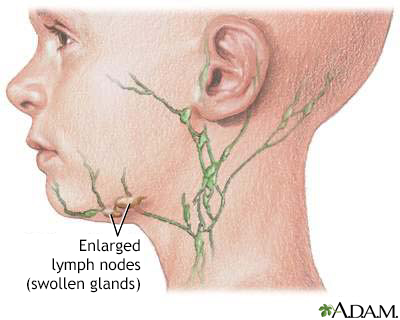Pregnancy SmartSiteTM
Mucocutaneous lymph node syndrome; Infantile polyarteritis; Kawasaki syndrome DefinitionKawasaki disease is a rare condition that involves inflammation of the blood vessels. It occurs in children. CausesKawasaki disease occurs most often in Japan, where it was first discovered. The disease is seen more often in boys than in girls. Most of the children who develop this condition are younger than age 5. Kawasaki disease is not well understood and the cause is yet unknown. It may be an autoimmune disorder. The problem affects the mucous membranes, lymph nodes, walls of the blood vessels, and the heart. SymptomsKawasaki disease often begins with a fever of 102°F (38.9°C) or higher that does not go away. The fever is often as high as 104°F (40°C). A fever lasting at least 5 days is a common sign of the disorder. The fever may last for up to 2 weeks. The fever often does not come down with normal doses of acetaminophen (Tylenol) or ibuprofen. Other symptoms often include:
Additional symptoms may include:
Exams and TestsTests alone cannot diagnose Kawasaki disease. Most of the time, the health care provider will diagnose the disease when a child has most of the common symptoms. In some cases, a child may have a fever that lasts more than 5 days, but not all the common symptoms of the disease. These children may be diagnosed with atypical Kawasaki disease. All children with fever lasting more than 5 days should be checked for Kawasaki disease by a provider. Children with the disease need early treatment for a good outcome. The following tests may be done:
Tests such as ECG and echocardiography are done to look for signs of myocarditis, pericarditis, and inflammation of the coronary arteries. Arthritis and aseptic meningitis can also occur. TreatmentChildren with Kawasaki disease need hospital treatment. Treatment must be started right away to prevent damage to the coronary arteries and heart. Intravenous gamma globulin is the standard treatment. It is given in high doses as a single infusion. The child's condition often gets much better within 24 hours of treatment with IV gamma globulin. High-dose aspirin is often given along with IV gamma globulin. Even with standard treatment, up to 1 in 4 children may still develop problems in their coronary arteries. In sicker children or those with signs of heart disease, adding corticosteroids is recommended. Tumor necrosis factor (TNF) inhibitors such as infliximab (Remicade) or etanercept (Enbrel) are not recommended for initial treatment. However, there still needs to be better tests to tell which children will benefit from these medicines. Outlook (Prognosis)Most children can recover fully when the disease is caught and treated early. About 1 in 100 children die from heart problems caused by the disease. People who have had Kawasaki disease should have an echocardiogram every 1 to 2 years to check for heart problems. Possible ComplicationsKawasaki disease can cause inflammation of blood vessels in the arteries, especially the coronary arteries. This can lead to aneurysm. Rarely, it can lead to a heart attack at a young age or later in life. When to Contact a Medical ProfessionalCall your provider if symptoms of Kawasaki disease develop. Cracked, red lips and swelling and redness develop in the affected areas such as the palms and soles of the feet. If these problems occur along with an ongoing high fever that does not come down with acetaminophen or ibuprofen, your child should be checked by a provider. PreventionThere are no known ways to prevent this disorder. ReferencesAbrams JY, Belay ED, Uehara R, Maddox RA, Schonberger LB, Nakamura Y. Cardiac complications, earlier treatment, and initial disease severity in Kawasaki disease. J Pediatr. 2017;188:64-69. PMID: 28619520 pubmed.ncbi.nlm.nih.gov/28619520/. American Academy of Pediatrics. Kawasaki disease. In: Committee on Infectious Diseases, American Academy of; Pediatrics, Kimberlin DW, Barnett ED, Lynfield R, Sawyer MH, eds. Red Book: 2021-2024 Report of the Committee on Infectious Diseases. 32nd ed. Itasca, IL: American Academy of Pediatrics; 2021. McCrindle BW, Rowley AH, Newburger JW, et al. Diagnosis, treatment, and long-term management of Kawasaki disease: a scientific statement for health professionals from the American Heart Association. Circulation. 2017;135(17):e927-e999. PMID: 28356445 pubmed.ncbi.nlm.nih.gov/28356445/. Nyhan A. Cardiology. In: Kleinman K, Mcdaniel L, Molloy M, eds. Harriet Lane Handbook, The. 22nd ed. Philadelphia, PA: Elsevier; 2021:chap 7. Xue LJ, Wu R, Du GL, et al. Effect and safety of TNF inhibitors in immunoglobulin-resistant Kawasaki Disease: a meta-analysis. Clin Rev Allergy Immunol. 2017;52(3):389-400. PMID: 27550227 pubmed.ncbi.nlm.nih.gov/27550227/. | |
| |
Review Date: 4/30/2023 Reviewed By: Neil J. Gonter, MD, Assistant Professor of Medicine, Columbia University, New York, NY, and private practice specializing in Rheumatology at Rheumatology Associates of North Jersey, Teaneck, NJ. Review provided by VeriMed Healthcare Network. Also reviewed by David C. Dugdale, MD, Medical Director, Brenda Conaway, Editorial Director, and the A.D.A.M. Editorial team. The information provided herein should not be used during any medical emergency or for the diagnosis or treatment of any medical condition. A licensed medical professional should be consulted for diagnosis and treatment of any and all medical conditions. Links to other sites are provided for information only -- they do not constitute endorsements of those other sites. No warranty of any kind, either expressed or implied, is made as to the accuracy, reliability, timeliness, or correctness of any translations made by a third-party service of the information provided herein into any other language. © 1997- A.D.A.M., a business unit of Ebix, Inc. Any duplication or distribution of the information contained herein is strictly prohibited. | |

 Kawasaki disease -...
Kawasaki disease -... Kawasaki's disease...
Kawasaki's disease... Swollen lymph node
Swollen lymph node
